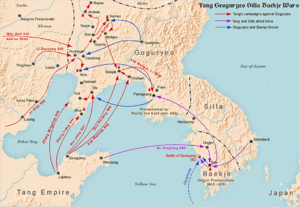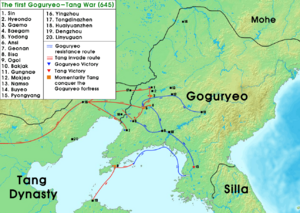Goguryeo–Tang War facts for kids
Quick facts for kids Goguryeo–Tang War |
|||||||||
|---|---|---|---|---|---|---|---|---|---|
 |
|||||||||
|
|||||||||
| Belligerents | |||||||||
Eastern Turkic Khaganate |
Yamato Mohe |
||||||||
| Commanders and leaders | |||||||||
|
Tang: |
Goguryeo: Baekje: Emperor Tenji Empress Saimei |
||||||||
| Casualties and losses | |||||||||
| Unknown but heavy | 200,000 captured at Pyongyang, 150,000 dead and captured at Mount Jupil, 10,000 dead at Baekgang, and 20,000 captured at Baekje | ||||||||
| Goguryeo–Tang War | |||||||
|---|---|---|---|---|---|---|---|
| Chinese name | |||||||
| Traditional Chinese | 唐與高句麗的戰爭 | ||||||
| Simplified Chinese | 唐与高句丽的战争 | ||||||
|
|||||||
| Korean name | |||||||
| Hangul | 고구려-당 전쟁 | ||||||
|
|||||||
The Goguryeo–Tang War was a big conflict that happened from 645 to 668. It was fought between the ancient Korean kingdom of Goguryeo and the powerful Tang dynasty of China. During this long war, both sides teamed up with other states. Goguryeo managed to push back the Tang armies during their first invasions from 645 to 648.
Later, after the Tang and Silla armies conquered Baekje in 660, they invaded Goguryeo again in 661. This time, they attacked from both the north and the south. However, they had to retreat in 662. In 666, a powerful Goguryeo general named Yeon Gaesomun died. This led to big fights and disagreements within Goguryeo, causing many people to leave and morale to drop.
The Tang and Silla alliance launched a new invasion the next year, helped by Yeon Gaesomun's son who had switched sides. By late 668, Goguryeo was very tired from many attacks and had a lot of internal problems. Goguryeo and the remaining Baekje soldiers finally lost to the larger armies of the Tang dynasty and Silla.
This war marked the end of the Three Kingdoms of Korea period, which had lasted since 57 BC. It also led to the Silla–Tang War, where Silla and the Tang Empire fought over the lands they had won.
Contents
Why Did the War Start?
Silla had asked the Tang for military help many times. They needed protection from the Kingdom of Goguryeo. The Tang court started thinking about helping Silla after they defeated the Göktürks in 628.
At the same time, Silla was also fighting with Baekje in 642. A year before, in 641, King Uija became the ruler of Baekje. In 642, King Uija attacked Silla and took control of about 40 strongholds.
Meanwhile, in Goguryeo, a military leader named Yeon Gaesomun took control in 642. He removed the king and put a new one in his place. These new leaders in Baekje and Goguryeo formed an alliance against Tang and Silla. They were getting ready for war.
Key Events of the War
The First Tang Invasion: 645
Emperor Taizong of Tang used the change in leadership in Goguryeo as a reason to start his campaign. He began preparing for an invasion in 644. General Li Shiji led an army of 60,000 Tang soldiers and many tribal forces. Emperor Taizong himself led 10,000 armored cavalry.
A fleet of 500 ships also carried 40,000 more soldiers and 3,000 volunteers. This fleet sailed from the Liaodong Peninsula to the Korean Peninsula.
In April 645, General Li Shiji's army started their march. On May 1, they crossed the Liao River into Goguryeo. On May 16, they attacked Gaimou (Kaemo). The city fell in just 11 days. The Tang army captured 20,000 people and a lot of grain.
After this, General Li Shiji's army moved to Liaodong (Ryotong). On June 7, they defeated a Goguryeo army of 40,000 troops. This army had been sent to help the city. A few days later, Emperor Taizong's cavalry arrived. On June 16, the Tang army set Liaodong on fire and broke through its walls. The city then fell to the Tang forces.
The Tang army continued to Baiyan (Paekam) and arrived there on June 27. The Goguryeo commanders gave up the city to the Tang army without a fight. Emperor Taizong ordered that the city should not be looted and its people should not be enslaved.
On July 18, the Tang army reached Ansi Fortress. A Goguryeo army, including Mohe troops, was sent to help Ansi. This reinforcing army had 150,000 troops. Emperor Taizong sent General Li Shiji with 15,000 troops to trick the Goguryeo forces. Another Tang force secretly went around to attack from behind.
On July 20, the two sides met at the Battle of Jupilsan. The Tang army won this battle. Most of the Goguryeo troops ran away after their defeat. The remaining Goguryeo troops fled to a nearby hill. They surrendered the next day after the Tang army surrounded them. The Tang forces captured 36,800 troops. Of these, 3,500 officers were sent to China. About 3,300 Mohe troops were executed, and the rest of the Goguryeo soldiers were released.
However, the Tang army could not get into the city of Ansi. The city was strongly defended by the forces of Yang Manchun. Tang troops attacked the fortress many times each day, but the defenders pushed them back every time. After weeks, Emperor Taizong thought about leaving Ansi to go deeper into Goguryeo. But Ansi was too dangerous to leave behind.
Eventually, Tang tried to build a huge mound to get over the walls. But the defenders captured it and held it. The Tang army also faced bad weather as winter was coming, and they were running out of food. So, Emperor Taizong had to order a retreat from Goguryeo on October 13. He left a valuable gift for the commander of Ansi Fortress. Taizong's retreat was difficult, and many of his soldiers died.
Taizong himself helped treat the injuries of the Göktürk generals Qibi Heli and Ashina Simo. Both were wounded during the campaign against Goguryeo.
The Fall of Goguryeo: 654–668
Under Emperor Gaozong's rule, the Tang Empire formed a military team with Silla. When Goguryeo and Baekje attacked Silla, Queen Seondeok of Silla sent a messenger to the Tang Empire to ask for urgent military help. In 650, Emperor Gaozong received a poem from Queen Jindeok of Silla. It was brought by Kim Chunchu, who later became King Muyeol of Silla.
In 653, Baekje teamed up with Yamato Wa (Japan). Even though Baekje was allied with Goguryeo, the Han River valley separated them. This made it hard for them to help each other quickly in a war. King Muyeol became the Silla king in 654. Between 655 and 659, Baekje and Goguryeo attacked Silla's borders. Silla again asked Tang for help.
In 658, Emperor Gaozong sent an army to attack Goguryeo, but they couldn't break through Goguryeo's strong defenses. King Muyeol suggested to Tang that they should first conquer Baekje. This would break the Goguryeo–Baekje alliance. Then, they could attack Goguryeo.
In 660, the Tang Empire and the Silla Kingdom sent their combined armies to conquer Baekje. The Baekje capital, Sabi, fell to the Tang and Silla forces. Baekje was conquered on July 18, 660, when King Uija of Baekje surrendered. The Tang army captured the king, the crown prince, 93 officials, and 20,000 soldiers. The king and crown prince were sent as prisoners to the Tang Empire. The Tang Empire took control of the land and set up five military offices to rule the area. Silla had to accept this, even though it was difficult.
In a final effort, General Gwisil Boksin led a resistance against Tang's control of Baekje. He asked for military help from their Yamato allies. The Nihongi Chronicles say that during his pleas, Prince Buyeo Pung was given a special cap and married to a Japanese noblewoman. Emperor Tenji of Japan sent 4,000 men to escort Prince Buyeo Pung back to his country. General Gwisil Boksin met him and gave him control of the land.
The Tang fleet, with 170 ships, moved towards Chuyu and surrounded the city at the Baekgang River. When the Yamato fleet fought the Tang fleet, they were attacked and destroyed. In 663, the Baekje resistance and Yamato forces were completely defeated by the Tang and Silla forces at the Battle of Baekgang. After this, Prince Buyeo Pung of Baekje and his remaining men fled to Goguryeo.
The local people rebelled and surrounded Liu Renyuan in the capital until Liu Rengui brought more soldiers. The situation was a stalemate, with Baekje holding some cities and Silla and Tang holding others. In the autumn of 663, a combined Tang-Silla army marched to Chuyu, the capital of the rebels. Chuyu was captured on October 14, and the rebellion was crushed.
In the summer of 661, Su Dingfang led an army of 44,000 across the sea and attacked Pyongyang. Another Tang army under Qibi Heli moved by land. The Tang army was 350,000 strong, and Silla was only asked to provide supplies. Qibi Heli defeated a Goguryeo army at the Yalu River. However, Su Dingfang failed to take Pyongyang. The invasion was stopped in February 662. This was after failing to take Pyongyang for several months and when a smaller Tang force was defeated by Yeon Gaesomun at the Battle of Sasu.
In 666, the powerful Goguryeo leader Yeon Gaesomun died. A fight for power broke out among his sons. Goguryeo became weaker because of this struggle. His oldest son joined Tang, and his younger brother joined Silla. The big disagreements after Yeon Gaesomun's death were the main reason Tang and Silla won. This was due to the division, people switching sides, and low morale it caused.
Yeon Gaesomun's death opened the way for a new invasion by Tang and Silla in 667. This time, Yeon Gaesomun's oldest son helped them. The alliance with Silla was also very helpful. It allowed them to attack Goguryeo from different directions. Silla also provided military and logistical support.
In early 667, a Tang invasion of Goguryeo began, led by Li Shiji. The Tang army quickly took over border defenses and pushed into Goguryeo's main territory in the spring of 668. Tang and Silla forces surrounded and conquered Pyongyang on October 22. The Tang dynasty then took control of Goguryeo. Over 200,000 prisoners were taken by the Tang forces and sent to Chang'an.
What Happened After the War?
In 669, the Tang government set up the Protectorate General to Pacify the East. This office was meant to control the former lands of Goguryeo. A smaller office was also placed in Baekje. By the end of the war, the Tang Empire controlled the former lands of Baekje and Goguryeo. They also tried to take control over Silla. Large parts of the Korean Peninsula were occupied by Tang forces for about ten years.
However, Tang's control of the Korean Peninsula became difficult. They had problems getting enough supplies, which Silla had provided before. Also, Emperor Gaozong was getting sick. So, Empress Wu chose a more peaceful approach. The Tang Empire also needed to focus its resources on other important things. This situation helped Silla. Soon, Silla would have to fight against Chinese rule over the entire peninsula. A war between Silla and Tang was about to begin.
Images for kids



